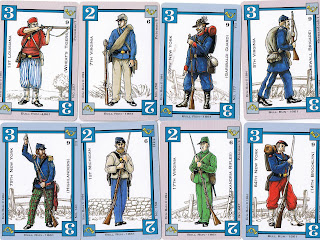On the other hand, Dixie wasn't a whole-hearted CCG in the form we've become accustomed to over the years.
For one thing, the game eschews the whole rarity thing. While randomly sorted for packaging, all the cards are equally rare (or common). This made collecting a full set somewhat less daunting. In addition, there aren't really a lot of different kinds of cards. The vast majority of the cards are infantry with "combat values" of 1 to 4. Most of the balance of the cards are leaders and artillery, with a handful of cavalry units. There are a few terrain cards and 23 "special" cards, which are the only ones "played" to affect various game functions. All the generals, infantry, artillery and cavalry cards are used to maneuver and fight on a notional battlefield divided into left, center and right sectors for each army.
Indeed, the combat system is basically a copy of the tactical battle board system used in Bobby Lee and similar to the tactical system of Napoleon.
As such this game is very familiar territory for wargamers. Deck construction is fairly straightforward. There are no killer card combos or any such considerations. Instead the player uses the available battle points to select a mix of cards. Both sides deploy their initial "muster" on the board with any additional cards arriving as reinforcements.
Players can "fire" their guns cross the "middle ground at the op[posing array and send infantry and cavalry units across the "middle ground" in an attempt to seize the enemy's home sectors. If an army captures two out of the three enemy home sectors they win.
Combat in all cases involves rolling as many dice as the unit;s combat value, with the effectiveness of that fire depending upon the type of unit. For example, infantry units fire at "F2" which means a die roll of 1 or 2 hits. For every hit a unit has taken it has to make a morale check at the beginning of its next turn If it rolls more than its CV, modified for any leadership, then it "routs" and is removed from play.
As one can see, larger CV units are doubly powerful, rolling more dice and having a greater chance of passing a morale check. On the other hand, they are also somewhat fragile, in a case of having all ones eggs in a single basket. A single hit followed by a bad die roll can make a 4CV unit run away, wheres it would take 4 hits to clear out four 1 CV units (with a chance that a lucky roll may save one.) Leaders tend to benefit poorer units more. A single 0/1 leader can double the chances that 1CV units will hold their ground defending a position.
Compared to most card games there is very little card interaction between players. Only a couple of special cards can be played to directly affect the opponent's cards (Uniform Confusion, Rebel Yell). No, this is very definitely a wargame, albeit on the abstract side.
One of the more interesting things from a wargamers point of view is the OB and uniform information contained in the game. The entire order of battle of both armies is included in the game, with illustrations of all the regimental uniforms. Bull Run was the first battle of the war and both armies were much more colorful than they would be later on.
Some examples:
There are federal units in gray, rebels in blue and other combinations galore.
Dixie is definitely a wargamers kind of collectible game. It's got the kind of collectibility that should appeal to wargamers -- uniforms and OB while avoiding the kind of annoying collectibility found in many other CCGs such as promo cards, ultra rares and the like.
And if you don't want to do it the hard way, Columbia also offers a one-with-everything set that skips the whole random box scene.
The basic game is a good, introductory level tactical battle game that may appeal to the non-wargaming friends. The large cards highlight the kind of visual attractiveness usually seen in miniatures game and it avoid hexes and other wargamey conventions in favor of a very intuitive right-center-left battlefield.

No comments:
Post a Comment